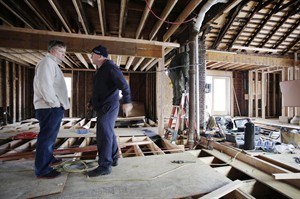David B. Caruso

In a Thursday, Dec. 20, 2012 photo, Joseph O'Grady, left, with Rockaway Reach, talks with Kevin Murphy as they discuss the renovation of Murphy's home in the Belle Harbor neighborhood of New York. Murphy's house was heavily damaged by flooding sea water during Superstorm Sandy on Oct. 29, 2012. More than 160 organizations and counting have gotten shares of the Sandy relief funds collected so far by the Robin Hood Foundation. Rockaway Reach works on behalf of Catholic Charities of San Diego, which has received funding from the Robin Hood Foundation. (AP Photo/Mark Lennihan)
December 31, 2012 - 4:30 PM
NEW YORK, N.Y. - Some of the biggest names in rock 'n' roll were on the bill for the nationally televised "12-12-12" concert benefiting victims of Superstorm Sandy, but the charity in charge of distributing donations has been thinking small when it comes to doling out the $50 million-plus raised by Bruce Springsteen, Paul McCartney, the Rolling Stones and other stars.
More than 160 organizations and counting have gotten shares of the Sandy relief funds collected so far by the Robin Hood Foundation, and many have been the type of small, grass-roots groups that seemed to be everywhere on the devastated New York and New Jersey coastlines in the initial weeks after the storm.
Some of the grants have been small, too, but the foundation's staff said each has been designed to make a difference on a human scale.
The list of grant recipients includes places like the Point Pleasant Presbyterian Church, of Point Pleasant Beach, New Jersey, which got $25,000 so it could install showers and beds for the stream of volunteers it has been deploying to help rebuild damaged homes.
Numerous food pantries got grants to help serve thousands of hot meals. Another group got $25,000 for making storage space available to families that need a temporary place to put salvaged possessions.
Robin Hood gave a $100,000 grant to an operation called Rockaway Relief, hastily put together after the storm by James Brennan, a San Diego nightclub and restaurant owner who grew up on New York City's flood-ravaged Rockaway peninsula.
In the days after the catastrophe in late October, Brennan hired tractor-trailers to send space heaters, water pumps and generators into the disaster zone. Then, he rallied volunteers to help rip out soggy walls and furniture. Since then, the group has repaired plumbing, electrical and heating systems in close to 100 homes, he said.
"This was really way over my head," Brennan said. "But there is so much more that these people need. I could probably rattle off 500 families right now that don't have washer and dryers and have no way of paying for them."
The foundation gave another $150,000 to the Mennonite Disaster Service, which has been dispatching home builders almost daily to New York City's Staten Island and the Rockaways all the way from Pennsylvania.
Volunteers, mostly rural farmers, leave Lancaster County, Pennsylvania, at 4 a.m., put in a full day mucking out homes and hanging drywall in the city, and then make the 170-mile (275-kilometre) drive back to Pennsylvania at night, said MDS Executive Director Kevin King. So far, they have worked on 117 houses.
"We are looking to set up a long-term camp," King said.
Founded in 1988 by a hedge fund manager, Paul Tudor Jones, the Robin Hood Foundation is one of New York City's premier anti-poverty charities. It spends about $125 million per year funding a wide array of food banks, schools, medical clinics, and other programs.
Still overseen and financed by big names on Wall Street, the charity is considered a pioneer in "venture philanthropy." The programs it funds are put through rigorous performance evaluations, with a goal of rewarding non-profit groups that achieve the strongest result per dollar spent.
The foundation's executive director, David Saltzman, said it has tried to apply some of those concepts to the Sandy relief effort.
"Our general strategy is to get out to the hardest-hit communities ... and see with our own eyes who is doing good work, and then be able to pump money into the strongest organizations doing the most needed work in the toughest-hit communities," he said. "That is the kind of grant-making you can't do from behind a desk."
Robin Hood was also in charge of distributing the $65 million raised by the Concert for New York after the Sept. 11, 2001, terrorist attacks.
Saltzman said that in the weeks ahead, he anticipated that the foundation would focus on housing — still a critical concern in neighbourhoods where many houses are still uninhabitable, or lack power and heat.
"We need to make sure nobody is freezing this winter in New Jersey, or New York or Connecticut," he said.
That effort has included making a $1 million grant to the Affordable Housing Alliance, in Monmouth County, New Jersey, which is using the money to buy and install manufactured homes for people displaced by the storm. Legal aid groups have also gotten donations to help storm victims maximize benefits from the Federal Emergency Management Agency and deal with banks and insurers.
Robin Hood has also made a $2 million grant to a program, administered by the Fund for the City of New York, that will make interest-free loans to non-profit groups that suffered losses in the storm.
"Not one single penny will be diverted to anything other than helping people who were hurt by this storm," Saltzman said.
News from © The Associated Press, 2012